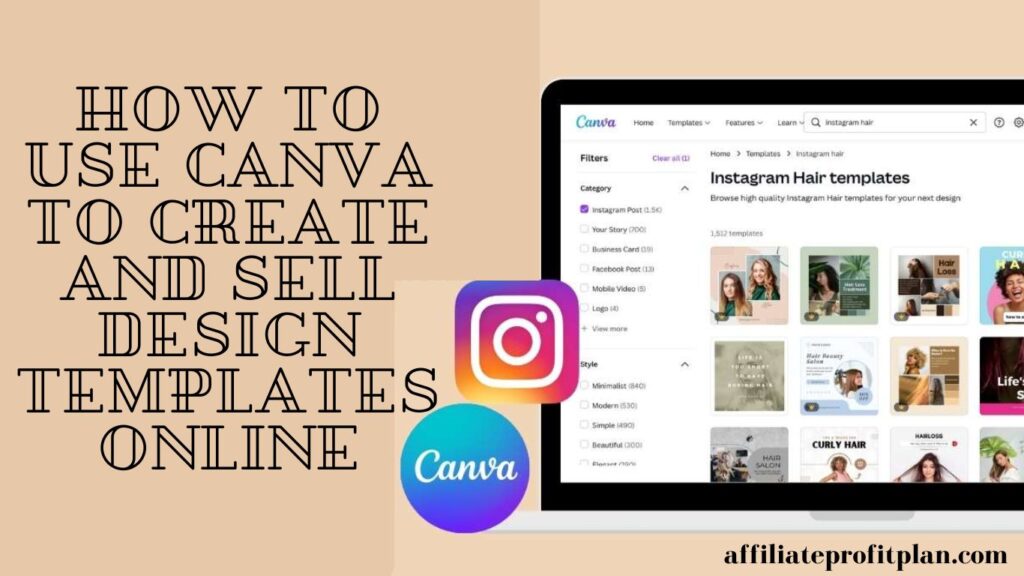Welcome to my article How to Use Canva to Create and Sell Design Templates Online. If you’ve ever found yourself scrolling through Instagram or Pinterest, enviously eyeing those flawless design templates, you’re not alone. The good news is: you can be the one creating and selling those templates! Thanks to Canva, a super user-friendly graphic design tool, you don’t need to be a professional designer to make eye-catching templates. With a bit of creativity and know-how, you can turn your design skills into a profitable online business.
But here’s the best part—Canva makes it ridiculously easy to create templates for social media posts, business materials, presentations, and more. Whether you’re looking to make money on the side or turn this into a full-time gig, selling templates is an excellent way to tap into the booming market of digital design. And while the idea of selling your creations might sound intimidating, trust me, it’s not as complicated as it seems. You don’t need an art degree or years of experience to get started—just a computer, Canva, and a little bit of hustle. In this article, we’ll break down everything you need to know about creating and selling Canva templates, from brainstorming design ideas to setting up your online store. So, if you’re ready to turn your passion for design into cold, hard cash, let’s dive in!
Access My Proven Blueprint for $50-$100 Daily Income – Watch This FREE Video Now >>>

Getting Started with Canva for Template Design
So, you’re ready to dive into the world of creating and selling design templates? Awesome! The first step on this exciting journey is to get comfortable with Canva, the magic tool that will turn your ideas into beautifully designed templates. And don’t worry—this isn’t some fancy, intimidating software that requires a degree in graphic design. Canva is user-friendly, intuitive, and perfect for beginners (and seasoned pros who want to save time).
Step 1: Creating a Canva Account
First things first—if you haven’t already, head over to Canva’s website and sign up. You can use it for free, but if you’re serious about selling templates, you might want to consider upgrading to Canva Pro. Why? Well, with Canva Pro, you unlock additional features like access to premium templates, advanced customization tools, and a bigger library of fonts and images—basically, all the things you’ll need to create top-tier templates.
Step 2: Navigating Canva’s Interface
Once you’re in, it’s time to explore! Canva’s interface is pretty straightforward. On the left side, you’ll see all your design options, including pre-made templates, your own designs, and folders to keep everything organized. The main screen is where the magic happens, and the drag-and-drop editor makes it so easy to add elements like text, images, icons, and backgrounds. It’s like playing Tetris—but with designs. The more you play around with it, the more you’ll learn.
Step 3: Choosing the Right Design Style
Now that you’ve got a feel for the platform, it’s time to think about what kind of templates you want to create. Do you want to make templates for social media graphics? Business cards? Presentations? Canva has templates for pretty much every category you can think of. A good idea here is to pick a niche that excites you. Not only will it make the process more fun, but you’ll also have a better chance of standing out in a specific market.
Step 4: Organizing Your Projects
Before you get too carried away, take a moment to set up your workspace in Canva. Create folders to keep all your templates organized, especially if you plan on creating a lot of them. You’ll thank yourself later when you don’t have to dig through endless pages of designs to find your latest creation. Plus, it makes your life easier when you’re ready to upload your designs for sale.
With your account set up and a clear plan in mind, you’re ready to jump into the design process. The good news is, Canva offers tons of pre-made templates you can customize. Or, if you’re feeling bold, start from scratch and create something truly unique. Either way, you’re now armed with the tools to make your template business a reality! So, grab your digital pen (or mouse, whatever works for you), and let’s start creating!
Designing Your Templates: Tips and Tricks
Alright, now that you’ve got the hang of Canva and your workspace is set up, it’s time to dive into the fun part: designing your templates! Whether you’re making social media graphics, business cards, or pitch-perfect presentations, there are a few key tips and tricks to keep in mind that will not only make your templates look professional but also ensure your customers love them. Ready to level up your design game? Let’s go!
1. Start with a Solid Foundation: Choose a Template or Blank Canvas
Canva gives you two options: you can either start from scratch with a blank canvas or customize an existing template. Both have their perks. Starting with a pre-made template can save you time, and if you’re new to design, it gives you a great base to work from. But, if you’re feeling adventurous (and want to flex your creative muscles), a blank canvas is a chance to make something completely unique. Just make sure you’re choosing the right size and dimensions for your template—after all, nobody wants an Instagram post that’s too big to upload or a business card that doesn’t fit in a wallet!
2. Keep It Simple, But Not Boring
One of the golden rules of design is “less is more.” You don’t need to clutter your template with 500 different fonts, bright neon colors, and dancing clip art (unless you’re designing a 90s-themed flyer, in which case, go wild). Simplicity is key! Focus on clean, minimalist designs with clear focal points. Use whitespace wisely, and don’t be afraid to leave some areas blank. A well-spaced, balanced template will always look more professional.
3. Play with Fonts and Colors Like a Pro
Here’s where you can really let your creativity shine—but with restraint, of course! Canva has a wide variety of fonts, so pick a pair that complements each other. A good rule of thumb is to use one font for the heading and a different one for body text, but make sure they don’t clash. Contrast is important, but readability is key—don’t sacrifice one for the other! As for colors, stick to a color palette that’s easy on the eyes. Canva’s color palettes make this easy, and you can always upload your own custom colors. Aim for consistency across your templates so your designs have a cohesive feel, whether they’re for Instagram posts, business flyers, or Pinterest pins.
4. Make It Editable and User-Friendly
You’re not just creating templates for yourself—you’re designing for your customers, and they need to be able to easily edit the templates to suit their needs. That means, when you’re creating your template, leave enough flexibility for customization. Use text boxes that can be easily updated, place images in designated areas where they can be swapped out, and make sure your design is clean and well-organized. You want your customers to feel empowered when they make edits, not frustrated because they can’t figure out how to change the font size or move an image.
5. Create Template Variations
Once you’ve nailed one design, think about how you can offer multiple versions of it. This doesn’t mean starting from scratch each time, but creating variations of the same template to appeal to different preferences. For example, you could create a series of Instagram story templates with slightly different color schemes or font choices. Or, you could tweak a business card design to offer versions for personal branding, freelance professionals, and corporate use. More options mean more opportunities for your customers to find exactly what they’re looking for!
6. Think About the End User’s Experience
Here’s a pro tip: always put yourself in your customer’s shoes. As you design your templates, think about how easy it will be for someone with little to no design experience to use them. This will make your templates not only more attractive but also more desirable. The goal is to create something that looks professional, is easy to use, and adds real value to your customers’ lives. If you can do that, you’ll be golden!
By following these design principles, you’ll create templates that are visually appealing, highly customizable, and functional. With Canva’s array of tools and your own creativity, you’ll be churning out top-quality templates in no time. So, get ready to impress your future customers with designs they can’t wait to use!
Customizing Your Templates for Sale
Now that you’ve created some killer templates, it’s time to put on your business hat and think about customization for your customers. After all, you’re not just designing for yourself anymore—you’re designing for people who are going to purchase and use your templates, and you want them to feel like they’ve made the perfect choice. Customizing your templates for sale is about adding that extra touch that will not only make them more attractive to buyers but also ensure your customers have an easy time using and editing them. Let’s dive into how to make your templates irresistible and ready to sell!
Access My Proven Blueprint for $50-$100 Daily Income – Watch This FREE Video Now >>>
1. Make Your Templates Fully Editable
One of the biggest selling points of digital templates is that they’re customizable. So, when you’re preparing your templates for sale, think about how easy it will be for the end user to make changes. Does the font size need adjusting? Can they change the background color with one click? Are all the elements grouped in an organized manner so they can quickly swap out photos or text?
When designing your templates in Canva, use text boxes, image placeholders, and well-defined sections so customers can easily edit or replace elements without feeling overwhelmed. It’s all about giving them flexibility while maintaining the integrity of the design. And don’t forget to leave instructions or a helpful note within the template for the user, showing them how to edit things. The simpler you make it, the more likely they’ll be to buy—and come back for more!
2. Add a Personal Touch with Branding
Even though your templates are ready to be used by anyone, a bit of personalization can go a long way. Consider adding branding elements to your templates to give them that professional, polished feel. For instance, if you’re selling business card templates, include a placeholder for a logo and an example of a brand color scheme. If you’re designing social media posts, add a space for a user’s unique brand message or hashtag. This not only makes your templates feel more personalized but also gives your customers a sense of how the design could work for their brand, making it more likely they’ll make a purchase.
You could even create a series of template bundles that fit a specific theme—like “Minimalist Business Cards” or “Bold and Modern Instagram Stories”—that all share similar branding elements. This will appeal to buyers looking for a cohesive design package, and it adds value to your template offering.
3. Provide Multiple File Formats
While Canva is a great tool for creating and customizing templates, some customers might prefer to work with other design software or need the template in a different format. To cater to a wider audience, consider offering your templates in multiple file formats. For example, you can create a Canva version of the template but also provide a PDF or PNG version for customers who need quick access to ready-to-use designs. Offering more file options makes it easier for your customers to use the templates in their preferred platforms, which is a huge bonus in their eyes.
Also, be sure to include clear instructions on how to download and edit the templates in different formats. A little guidance goes a long way, especially for first-time template buyers who might not be familiar with how Canva works.
4. Offer Customization Services
If you’re looking to really boost your sales, consider offering an additional service where you can customize the template for your customers. For example, if someone buys a social media template but wants it to align more closely with their brand colors, you can offer to tweak it for them for an extra fee. This personalized service not only adds value but also gives you the chance to make more money from your existing designs.
To promote this, you could add a note to your template listings offering this service and let potential buyers know they can reach out for more tailored changes. Think of it as a way to cater to customers who want the ease of a template but don’t have the time or skills to fully personalize it themselves.
5. Set Clear Licensing Terms
Last but certainly not least, it’s important to set up clear licensing terms for your templates. Make sure to define how your customers can use the templates. Can they use them for commercial purposes? Are they allowed to resell the templates, or is it strictly for personal use? This is crucial not only for protecting your intellectual property but also to give your customers clarity on how they can legally use what they’ve purchased.
You can even create a simple licensing document to attach with your templates or add a brief note about the licensing terms in the product description. It’s a small step that can help you avoid any confusion and ensure your buyers know exactly what they can—and can’t—do with your designs.
By customizing your templates for sale, you’re doing more than just making them “pretty”—you’re enhancing their functionality, usability, and appeal. Whether it’s through editable features, personalized branding, multiple formats, or customization services, every little tweak you make adds value to your templates and ensures you’re giving your customers a seamless experience. And when your templates are easy to use, flexible, and perfectly tailored to your buyers’ needs, you’re not just selling a product; you’re selling a solution.
Selling Your Canva Templates Online
Now that your Canva templates are polished, customizable, and irresistible, it’s time to move them from your creative workspace to the bustling digital marketplace. Selling Canva templates online is where creativity meets entrepreneurship—it’s all about finding the right platform, crafting a compelling listing, and marketing your designs to the perfect audience. Here’s how to turn your design side hustle into a full-blown online income stream.
1. Choose the Right Selling Platforms
The first step to selling your templates is finding the perfect platform to showcase your work. The internet is brimming with options, each catering to different audiences and offering various features. Some popular platforms for selling digital products include:
- Etsy: A hub for handmade and digital products, Etsy is perfect for reaching a creative, design-savvy audience. Templates for weddings, small businesses, and social media often perform well here.
- Creative Market: A go-to marketplace for professional designers and marketers. If your templates have a polished, business-oriented vibe, this platform is worth exploring.
- Gumroad: Ideal for creators who want a simple, hassle-free way to sell digital products directly to their audience.
- Your Own Website: If you want complete control over branding and profits, creating a personal website or online store using platforms like Shopify or WordPress is a great option.
Each platform has its pros and cons, so choose the one that aligns best with your goals, audience, and the type of templates you’re offering.
2. Write a Killer Product Listing
Let’s face it: even the best-designed template won’t sell itself. Your product listing is the first impression potential buyers have of your work, so make it count! Start with a catchy, keyword-rich title that grabs attention (and performs well in search engines). For example, instead of “Instagram Template,” go with “Modern Instagram Story Templates for Small Businesses – Editable in Canva.”
Next, write a compelling description that highlights the benefits of your templates. Focus on what makes them unique—are they perfect for time-strapped entrepreneurs? Tailored for social media managers? Easy to use for Canva beginners? Be sure to include specific details like:
- The types of templates included (e.g., Instagram posts, business cards, etc.).
- The level of customization available.
- Instructions for use (especially if Canva is new to your audience).
Pair this with high-quality preview images or mockups that showcase your templates in action. This visual element can make or break your sales—people need to see how amazing your designs are!
3. Price Your Templates Strategically
Pricing can feel like a puzzle, but it’s an important part of selling your templates. Research what similar templates are selling for on your chosen platform, and consider your target audience when setting your prices. A simple social media template might go for $10-$20, while a detailed business branding kit could fetch $50 or more.
Don’t undersell yourself just because you’re starting out, but also make sure your pricing reflects the value customers will receive. Offering bundles or tiered pricing is another great strategy to attract buyers—after all, who can resist getting “more for less”?
4. Promote, Promote, Promote
Creating amazing templates is only half the battle—getting people to notice them is the other half. Use social media platforms like Instagram, Pinterest, and TikTok to showcase your templates. Pinterest, in particular, is a goldmine for driving traffic to digital products. Create visually appealing pins that link directly to your shop, and watch as potential buyers flock to your listings.
Another effective method is collaborating with influencers or bloggers in your niche. Offer them a free template in exchange for a shoutout or a review. And don’t underestimate the power of email marketing—if you have a subscriber list, send them updates about new templates or exclusive discounts.
If you’ve set up shop on Etsy or Creative Market, take advantage of their built-in SEO tools. Use relevant keywords in your product titles, descriptions, and tags to increase visibility and rank higher in search results.
5. Provide Excellent Customer Service
A happy customer is a returning customer, so make sure your buyers have a seamless experience. Respond promptly to inquiries, provide clear instructions for downloading and editing your templates, and be willing to offer help if someone gets stuck. Consider including a small PDF guide with each purchase, outlining the steps for customizing your templates in Canva.
After a successful sale, encourage buyers to leave a review. Positive feedback not only boosts your credibility but also makes future customers more likely to trust your products. If you’re selling on Etsy or Creative Market, reviews can be a game-changer for your shop’s success.
Selling Canva templates online is more than just uploading a design—it’s about creating an experience that makes your customers feel empowered, inspired, and thrilled with their purchase. By choosing the right platform, crafting a standout listing, and actively promoting your work, you’ll turn your passion for design into a profitable business. Now, go out there and sell like a Canva ninja! 💻🎨
Growing Your Template Business
So, you’ve dipped your toes into the world of selling Canva templates, and sales are starting to roll in. Congratulations! But why stop there when you can scale up and turn your side hustle into a thriving online empire? Growing your template business isn’t just about making more templates—it’s about building a brand, reaching new audiences, and streamlining your operations for maximum success. Let’s dive into how you can level up your business like a pro.
1. Niche Down or Expand Thoughtfully
When it comes to scaling your template business, one of the first decisions you’ll face is whether to niche down further or diversify your offerings.
- Niche Down: If you’ve found a sweet spot—like templates for wedding photographers or fitness coaches—lean into it. Create bundles, seasonal updates, and complementary designs tailored to that niche. The more specialized you are, the more likely your audience will view you as the go-to designer for their needs.
- Expand Thoughtfully: If your audience has varied interests, consider branching out to related niches. For instance, if you’re already selling Instagram templates, why not add Facebook or TikTok designs? Or expand from social media to printable planners, business cards, or branding kits. The key is to keep your designs cohesive while appealing to a broader audience.
2. Leverage Social Proof and Testimonials
Nothing convinces potential buyers quite like seeing glowing reviews from happy customers. Actively encourage your buyers to leave feedback or share their finished projects using your templates. Feature testimonials on your product listings, website, or social media to build trust and credibility.
Better yet, showcase user-generated content! If a client posts about how they used your template to grow their business or organize their life, share it (with permission, of course). This not only shows your product in action but also creates a sense of community around your brand.
3. Build an Email List
The saying goes, “The money is in the list,” and it holds true for digital product businesses. Growing an email list allows you to connect directly with your audience, promote new products, and offer exclusive discounts.
Start by offering a freebie, like a mini-template or design checklist, in exchange for email sign-ups. Once people are on your list, nurture them with valuable content, tips, and updates about your shop. When you launch a new product or run a sale, your email subscribers will likely be the first to buy.
4. Use Social Media to Your Advantage
Social media platforms like Instagram, Pinterest, and TikTok are your best friends when it comes to growing your template business. Each platform has its unique strengths:
- Instagram: Post eye-catching previews of your templates, share behind-the-scenes content, and engage with your followers through Stories or Reels.
- Pinterest: This platform is a goldmine for driving traffic to your shop. Create visually appealing pins with keywords and links to your templates. Since Pinterest acts like a search engine, your designs can reach people long after you’ve posted.
- TikTok: Short, engaging videos showcasing your design process or before-and-after transformations can go viral and bring in a wave of new customers.
Consistency is key here. Show up regularly, use hashtags effectively, and interact with your audience to keep your business top of mind.
5. Collaborate with Other Creators
Two heads (or brands) are often better than one when it comes to growth. Partner with other Canva creators, influencers, or complementary businesses to expand your reach.
For example:
- Collaborate with a fellow designer to create a bundle of templates, offering a mix of styles and features that appeal to a broader audience.
- Team up with influencers or bloggers in your niche. Offer them a free template in exchange for a shoutout, review, or social media post. Their audience might just become your next loyal customers.
Partnerships like these not only increase your visibility but also lend extra credibility to your brand.
6. Optimize and Automate
As your business grows, managing everything manually can quickly become overwhelming. Enter automation tools and optimization strategies to save your sanity.
- Use tools like Canva for Teams to streamline your workflow and keep your designs organized.
- Automate email campaigns with platforms like Mailchimp or ConvertKit, so you can nurture leads while you sleep.
- Optimize your product listings by refining your titles, descriptions, and tags based on what’s working best. Regularly update your listings with fresh images and keywords to stay relevant in search results.
Additionally, consider outsourcing tasks like customer service, marketing, or even template design as your business scales. Delegating frees up your time to focus on creating new products and growing your brand.
7. Keep Learning and Adapting
The digital product market is always evolving, so staying on top of trends is crucial. Invest in online courses or watch tutorials to improve your design skills and keep up with Canva updates. Pay attention to market demand—are clients asking for a specific type of template? Are new platforms or trends emerging that you could tap into?
By staying adaptable and continuously improving, you’ll ensure your template business remains relevant and profitable for the long haul.
Growing your Canva template business is about more than just selling designs—it’s about creating a brand, connecting with your audience, and delivering value at every turn. With the right strategies and a little perseverance, you’ll not only boost your income but also enjoy the satisfaction of turning your creativity into a thriving online business. Now, let’s get designing—and growing! 🎨🚀
Conclusion: Start Designing and Selling Templates Today
You’ve got the tools, the tips, and (hopefully) a head full of ideas ready to burst onto the digital design scene. Whether you’re a Canva newbie or a seasoned design whiz, selling templates online is a golden opportunity to turn your creativity into a steady income stream. And the best part? You don’t need a fancy art degree, a massive budget, or a million followers to get started—just a knack for design and a willingness to experiment.
Access My Proven Blueprint for $50-$100 Daily Income – Watch This FREE Video Now >>>
Why Wait? The Market is Ready for You
The demand for digital templates is hotter than ever. Businesses need polished social media posts, coaches want sleek workbooks, and regular folks crave aesthetic planners to organize their lives. With Canva’s intuitive tools, you can whip up professional-looking designs faster than you can decide which coffee to order.
What’s more, selling templates isn’t just a “set it and forget it” gig—it’s a scalable venture. Once you’ve uploaded your designs, they can sell over and over again. Add in some marketing magic, and you could have a passive income stream that runs while you sleep (or binge your favorite Netflix series).
Embrace the Learning Curve
If you’re feeling a bit overwhelmed, don’t sweat it. Nobody starts out as a Canva template tycoon. The key is to take small steps: experiment with designs, test different niches, and pay attention to what sells. With each sale, your confidence will grow—and so will your wallet.
Remember, this journey is as much about learning as it is about earning. Whether your first template is a runaway hit or a slow burner, every experience teaches you something valuable. And with Canva constantly rolling out new features, the possibilities for your designs are endless.
Start Today, Thank Yourself Tomorrow
The world is filled with people who say, “I’ll do it someday.” But you? You’re not a someday person—you’re a today person. So fire up Canva, get designing, and put those templates out there. Your audience is waiting, and your future self (the one sipping coffee on a beach, funded by template sales) will thank you.
The creative world of Canva templates is your oyster. All you need to do is crack it open and dive in. So go on, get started, and turn your designs into dollars! 💸🎨
Thanks a lot for reading my article on “How to Use Canva to Create and Sell Design Templates Online“ till the end. Hope you’ve helped. See you with another article.










